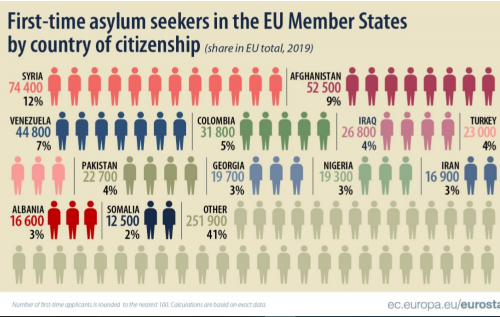Asylum in the EU Member States 612 700 first-time asylum seekers registered in 2019, up by 12% compared with 2018
Syrians, Afghans and Venezuelans: the top citizenships
In 2019, 612 700 first-time asylum seekers applied for international protection in the 27 Member States of the European Union (EU), up by 12% compared with 2018 (549 000), but around half of the number recorded in the peak year 2015 when 1 216 900 first-time asylum applicants were registered.

Syrian (74 400 first-time applicants) and Afghan (52 500) continued to be the main citizenship of people seeking international protection in the EU Member States in 2019, followed by Venezuelan (44 800), which moved up from fifth place in 2018 to third in 2019, together accounting for 28% of all first-time applicants.

These data on asylum applicants in the EU are issued by Eurostat, the statistical office of the European Union. They are complemented with an article and an infographic available on the Eurostat website.

Almost 1 in 4 applied for asylum in Germany With 142 400 first-time applicants registered in 2019, Germany accounted for 23% of all first-time applicants in the EU Member States. It was closely followed by France (119 900, or 20%) and Spain (115 200, or 19%), ahead of Greece (74 900, or 12%) and Italy (35 000, or 6%).
Among EU Member States with more than 5 000 first-time asylum seekers in 2019, the number of first time applicants rose most compared with the previous year in Spain (+118%, or 62 400 more first-time asylum seekers in 2019 than in 2018) and Cyprus (+67%, or 5 100 more), ahead of Sweden (+28%, or 5 000 more), Belgium (+27%, or 5 000 more), Greece (+15%, or 9 900 more), the Netherlands (+10%, or 2 000 more) and France (+8%, or 8 500 more).
In contrast, the largest relative decreases were recorded in Italy (-34%, or 18 400 fewer), Germany (-12%, or 19 400 fewer) and Austria (-7%, or 800 fewer).
Syrian, Afghan and Venezuelan – main citizenships of asylum seekers Syrian (12% of the total number of first-time applicants) was the main citizenship of asylum seekers in the EU Member States in 2019, a position it has held each year since 2013. Of the 74 400 Syrians who applied for asylum for the first-time in the EU in 2019, more than half were registered in Germany (39 300, or 53%). Syrian was the main citizenship of asylum seekers in seven EU Member States.
With 52 500 first-time applicants (or 9% of the EU total) in 2019, Afghan was the second main citizenship of asylum seekers in the EU Member States. Almost half of Afghans (45%) applied in Greece (23 700). Afghan was the main citizenship of asylum seekers in five EU Member States.
Venezuelan (7% of the total number of first-time applicants) was the third main citizenship of asylum seekers in the EU Member States in 2019. Of the 44 800 Venezuelans seeking asylum protection for the first-time in the EU in 2019, the vast majority (90%) applied in Spain (40 300). Venezuelan was the main citizenship of asylum seekers only in Spain.
While the number of applicants from Syria decreased compared to 2018 (-7%, or 5 700), the number of Afghans and Venezuelans increased by 35% (13 600) and 102% (22 600) respectively.
Highest number of first-time applicants relative to the population in Cyprus, lowest in Slovakia The highest number of registered first-time applicants in 2019 relative to the population of each Member State was recorded in Cyprus (14 495 first-time applicants per million population), ahead of Malta (8 108), Greece (6 985) and Luxembourg (3 585).
In contrast, the lowest numbers were recorded in Slovakia (39 applicants per million population), Hungary (48), Poland (73), Estonia (76) and Latvia (93).
In 2019, in the EU as a whole, there were 1 371 first-time asylum applicants per million population.
Around 840 000 asylum applications pending at the end of 2019 Pending applications for international protection are applications that have been made at any time and are still under consideration by the national authorities at the end of the reference period. In other words, they refer to the number of asylum seekers waiting for a decision at the end of the year. This statistic is also intended to measure how the national authorities are facing the workload implied by the arrival of asylum applicants in the Member States.
At the end of 2019, 842 500 applications for international protection in the EU Member States were still under consideration by the national authorities. At the end of 2018, this figure was slightly higher (851 000).
Germany had the largest share of applications pending in the EU at the end of 2019 (326 800, or 39% of the EU total), ahead of Spain (133 000, or 16%), Greece (105 400, or 13%), France (74 400, or 9%) and Italy (47 000, or 6%).
Among EU Member States with more than 5 000 pending applications at the end of 2019, the number of pending applications rose most compared with the previous year in Cyprus (+85%, or 8 600 more pending applications in 2019 than in 2018), Spain (+69%, or 54 300 more), and Belgium (+49%, or 9 500 more).
The largest relative decreases were recorded in Italy (-54%, or 56 000 fewer), Austria (-29%, or 10 900 fewer) and Sweden (-27%, or 10 100 fewer).
source: Eurostat
- 393 reads
Human Rights
Ringing FOWPAL’s Peace Bell for the World:Nobel Peace Prize Laureates’ Visions and Actions

Protecting the World’s Cultural Diversity for a Sustainable Future

The Peace Bell Resonates at the 27th Eurasian Economic Summit

Declaration of World Day of the Power of Hope Endorsed by People in 158 Nations

Puppet Show I International Friendship Day 2020

